Special Report
12 States Where Anyone Can Carry A Concealed Weapon
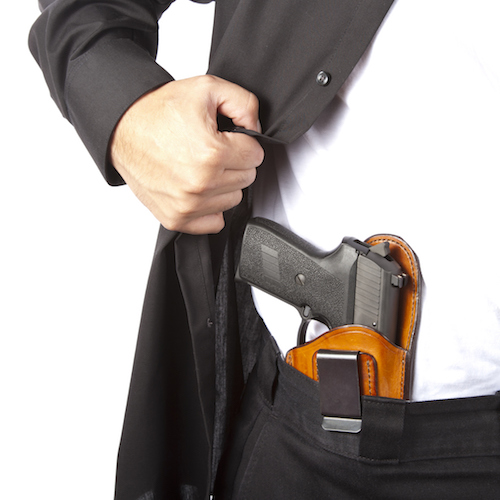
Published:
Last Updated:

The right to keep and bear arms in the United States originally resulted from the conviction that individuals have the right to self defense. Today, this right is enshrined by the U.S. constitution. However, the alarming number of high-profile mass shootings in the last decade, from Columbine to Virginia Tech to Sandy Hook to Orlando, as well as the over 100,000 Americans who are injured by guns each year, have led many to question this relatively unrestricted Constitutional right.
The United States has some of the least restrictive gun laws compared to Western countries. For instance, every state allows at least some residents to carry concealed weapons, and most states do not require background checks for private gun sales. However, there are only 12 states where just about anyone can have a gun. In these states anyone can carry a concealed weapon without a permit or background check.
Approximately one in three adults nationwide own a gun. In eight of the 12 states on this list, adult gun ownership is higher than the national rate. In four of these — Alaska, Idaho, West Virginia, and Wyoming — more than half the adults own a firearm and are among the top five in the country by this measure.
In states with relaxed gun laws, gun ownership tends to be higher, which might lead to higher death rates. “We can only speculate, but it does seem that the U.S. has more privately held guns than any other country in the world, yet we have much higher rates of gun deaths and shootings than other developed nations,” said Allison Anderman, managing attorney with the Law Center to Prevent Gun Violence, in an interview.
In nine of the 12 states that allow concealed carry without a permit firearm-related death rates exceed the national average of 11.1 deaths for every 100,000 Americans, and in eight of these nine states gun ownership rates are above average.
Click here to see the states where anyone can carry a concealed weapon.
Click here to see our detailed findings and methodology.
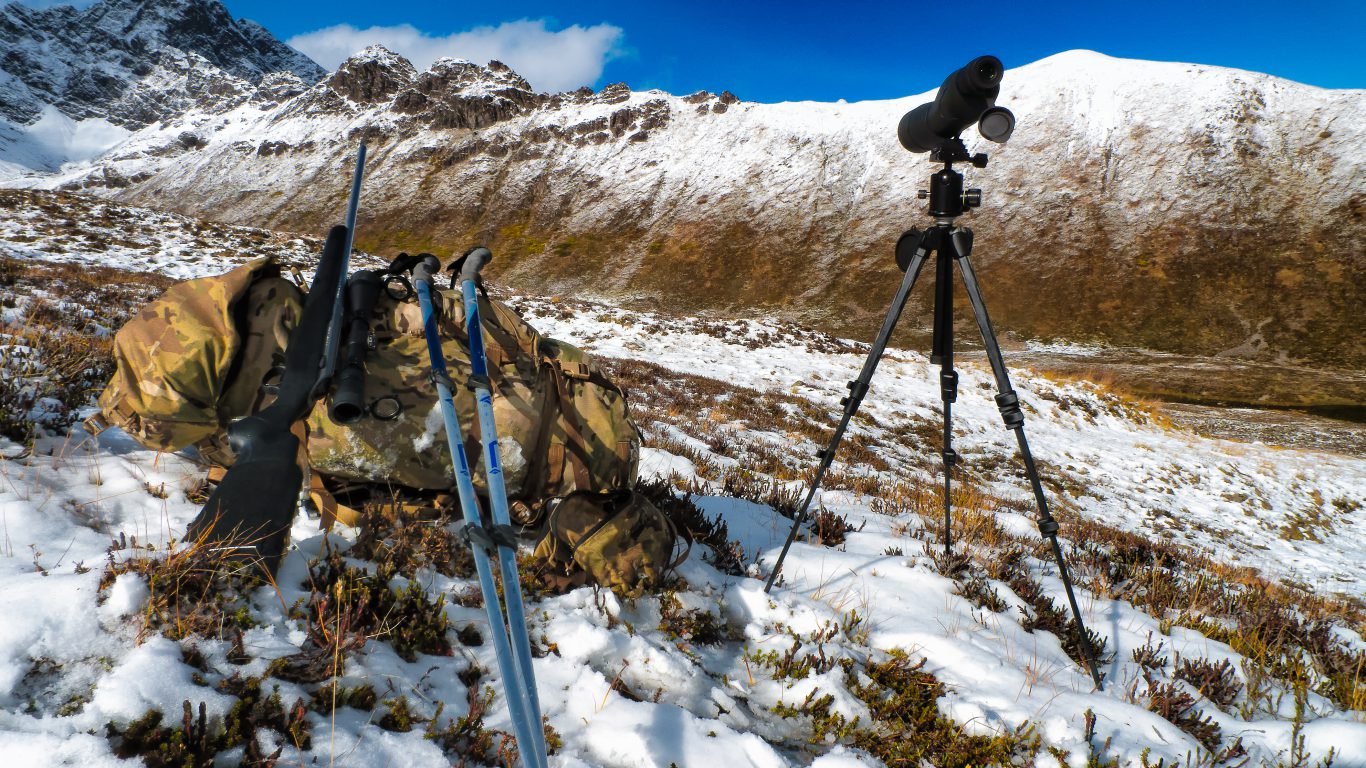
1. Alaska
> Concealed carry permit required: No
> Gun ownership rate: 61.7% (the highest)
> Firearm-related death rate: 23.4 per 100,000 (the highest)
The presence of firearms increases the likelihood of gun violence — accidental or otherwise. In Alaska, 61.7% of the adult population owns a gun, the highest gun ownership rate of any state. There were also 23.4 gun deaths per 100,000 residents in Alaska in 2015, the highest firearm fatality rate in the U.S.
In addition to relatively unrestricted concealed carry, Alaskans do not need a background check to purchase firearms from private dealers. They are also not subject to a waiting period when buying a gun, and adults in the state are allowed to purchase assault rifles, .50 caliber firearms, and high capacity ammunition magazines.
[in-text-ad]

2. Arizona
> Concealed carry permit required: No
> Gun ownership rate: 32.3% (25th highest)
> Firearm-related death rate: 13.8 per 100,000 (18th highest)
Arizona has some of the least restrictive gun laws in the country. Consumers in the state can buy as many firearms as they want in a single exchange, including .50 caliber weapons and assault rifles, with no waiting period. And if they buy from a private seller, also without a background check.
In 2011, Jared Loughner killed six and injured 13 more, including his primary target Arizona Congresswoman Gabrielle Giffords, in a mass shooting outside a Tucson grocery store. Loughner legally purchased the murder weapon in Arizona after he had been rejected by the Army for failing a drug test and was suspended from college for erratic behavior.
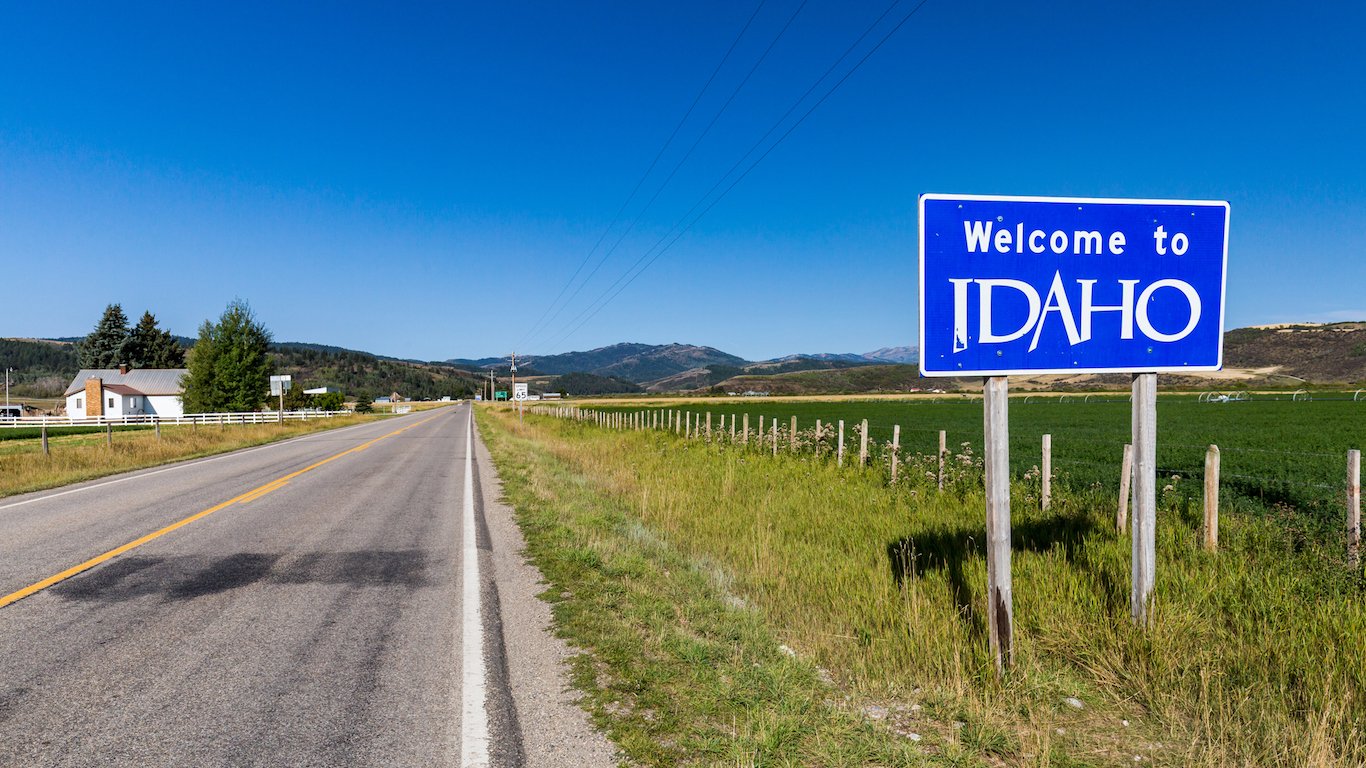
3. Idaho
> Concealed carry permit required: No
> Gun ownership rate: 56.9% (3rd highest)
> Firearm-related death rate: 14.7 per 100,000 (15th highest)
Idaho is one of only six states where over half of all adults are gun owners. Gun restrictions in the state are few. State residents do not need a permit to purchase or carry rifles, shotguns, or handguns, nor do they need to register their firearms or obtain an ownership license.
Idaho is one of the latest to join the ranks of states that do not require concealed carry permits. In March 2016, the state senate voted 54-15 in favor of loosening concealed carry restrictions. The law, Senate Bill 1389, went into effect July 1, 2016. State residents still need a Concealed Weapons License to carry a concealed firearm in k-12 schools and college campuses, public or private.
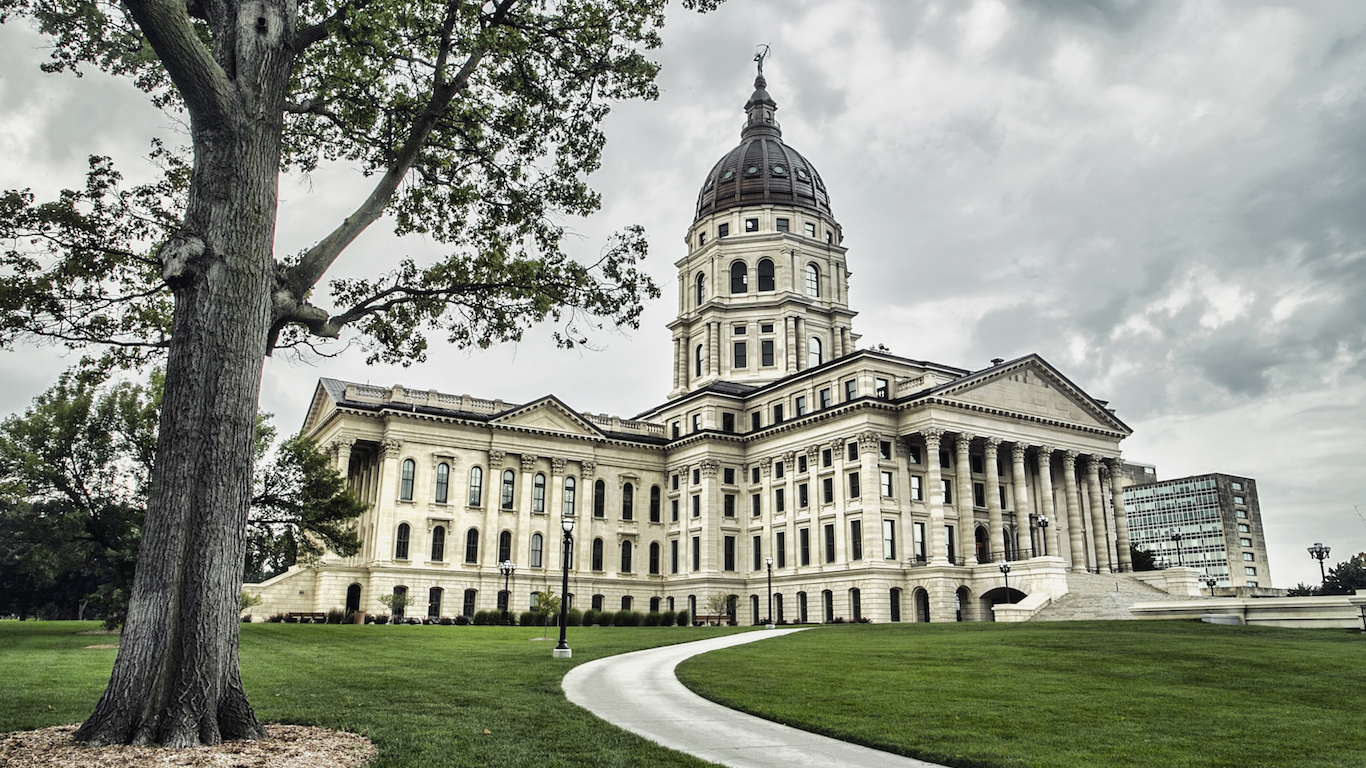
4. Kansas
> Concealed carry permit required: No
> Gun ownership rate: 32.2% (25th lowest)
> Firearm-related death rate: 11.4 per 100,000 (21st lowest)
Under the NRA endorsed Personal and Family Protection Act, signed into law in 2012, adults in Kansas have been allowed to carry a concealed weapon without a license or a permit since 2013. A unique provision in the law that went into effect July 1, 2017 now allows gun owners to carry concealed weapons on the campuses of the state’s six public universities as well as in community colleges and technical schools statewide. For many legislators, the law is intended to make state colleges safer — though the law is widely unpopular among employees in Kansas schools.
An estimated 32.2% share adults Kansas own firearms, a slightly larger share than the 29.1% U.S. gun ownership rate.
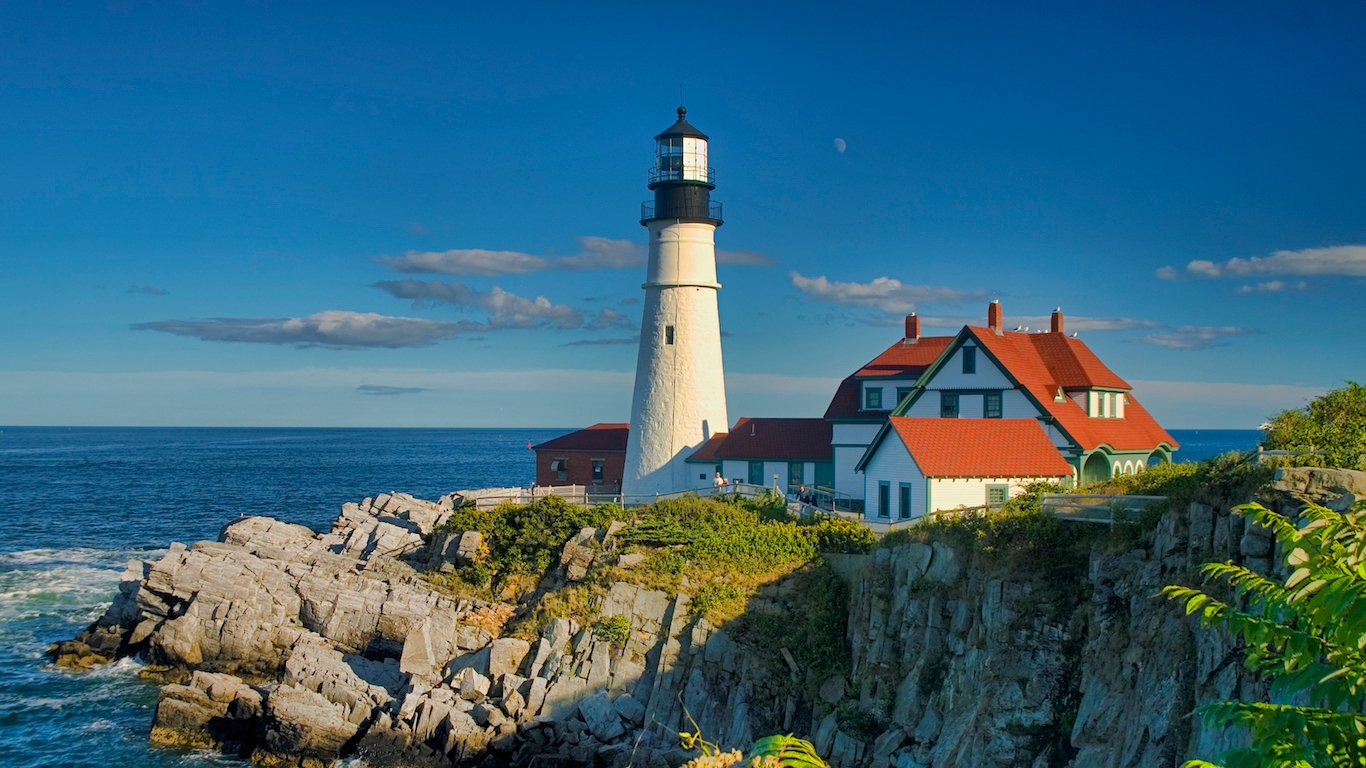
5. Maine
> Concealed carry permit required: No
> Gun ownership rate: 22.6% (12th lowest)
> Firearm-related death rate: 9.8 per 100,000 (15th lowest)
As has generally been the case across the United States, Maine has loosened its gun restrictions in recent years. Already a state with relatively lax gun laws, a 2015 law allowed legal firearm owners to carry concealed handguns without a permit. Before the law, Mainers who wanted to carry concealed weapons needed a police-issued permit. Such a permit required an extensive background check, including documented criminal history, domestic violence investigations, drug use and mental health disorders, and proof that the applicant had taken a gun safety course. Now, Maine is one of three New England states, along with Vermont and New Hampshire, to allow residents to carry a concealed, loaded weapon in public.
Maine is unusual among states with such lax gun laws in its relatively low gun ownership and gun death rates. An estimated 22.6% of Maine’s adult population owns firearms, versus the national gun ownership rate of 29.1%. There are 10 firearm related deaths for every 100,000 Maine residents annually, also one of the lower such rates of all states.
[in-text-ad]
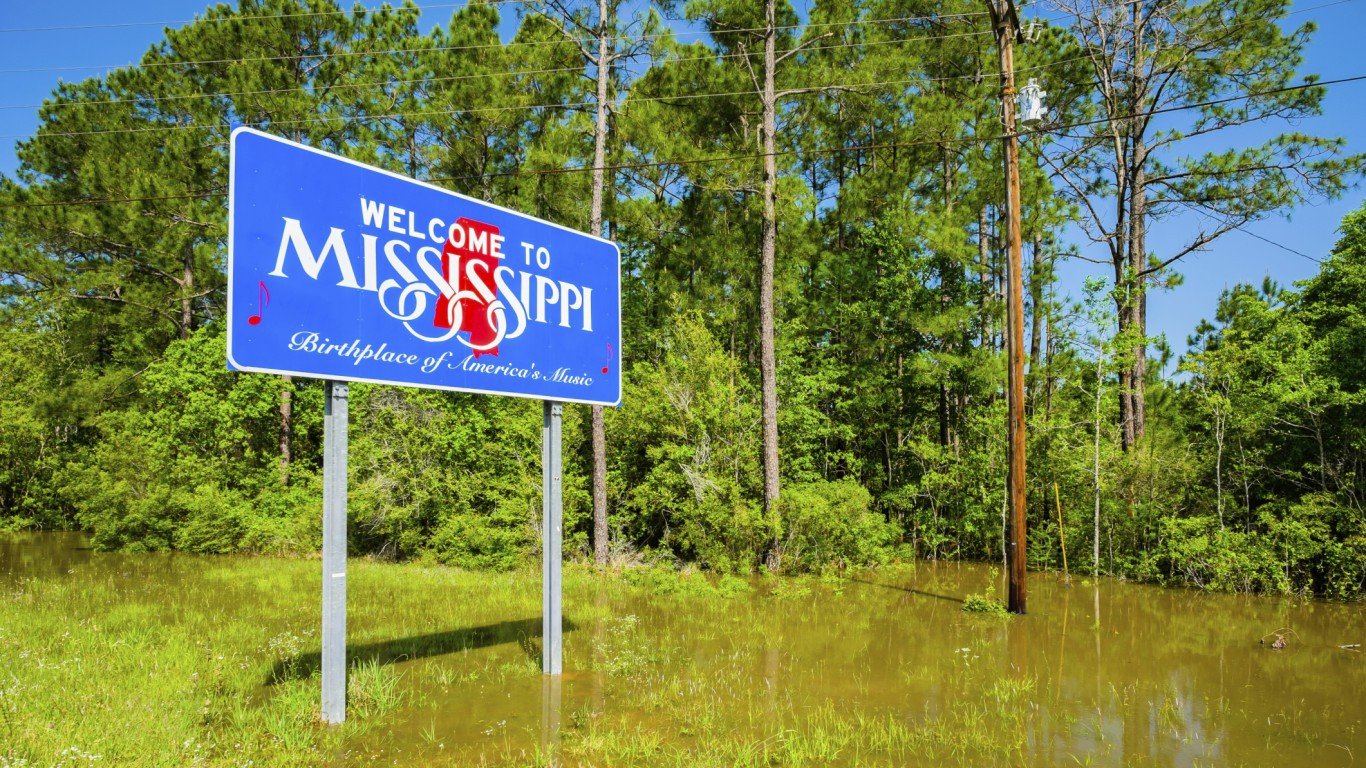
6. Mississippi
> Concealed carry permit required: No
> Gun ownership rate: 42.8% (13th highest)
> Firearm-related death rate: 19.6 per 100,000 (3rd highest)
Mississippi residents do not need a license or registration to purchase and own firearms. Adults in the state can also legally bypass the federally mandated background check prerequisite by purchasing firearms from private dealers.
States with less restrictive gun laws typically have more gun owners, and as gun ownership rates go up, the incidence of gun violence often does too. Mississippi is no exception. An estimated 42.8% of adults in the state own firearms, one of the higher shares among all states. Additionally, there were 19.6 firearm deaths, accidental or otherwise, for every 100,000 state residents in 2015, the third highest gun death rate in the country after only Alaska and Louisiana.

7. Missouri
> Concealed carry permit required: No
> Gun ownership rate: 27.1% (16th lowest)
> Firearm-related death rate: 18.1 per 100,000 (8th highest)
Missouri’s gun restrictions have weakened considerably over the past 10 years, according to Allison Anderman, an attorney at the Law Center to Prevent Gun Violence. Although Missouri’s governor vetoed a bill that would loosen the state’s concealed carry laws, legislators overrode the veto in September 2016. As a result, effective January 1, 2017, anyone in Missouri is allowed to carry concealed weapons in most places without obtaining a permit. The new legislation also eliminates the requirement that people undergo background checks before purchasing handguns through private sales.
A paper published by Stanford researcher John Donohue in June 2017 found evidence that right-to-carry laws are directly related to violent crime increases. An analysis of 10 years of data found that the increase in Missouri’s homicide rate was tied to its 2004 right-to-carry law. For every 100,000 state residents, 18.1 were killed by firearms in 2015, the eighth highest firearm death rate of all states.
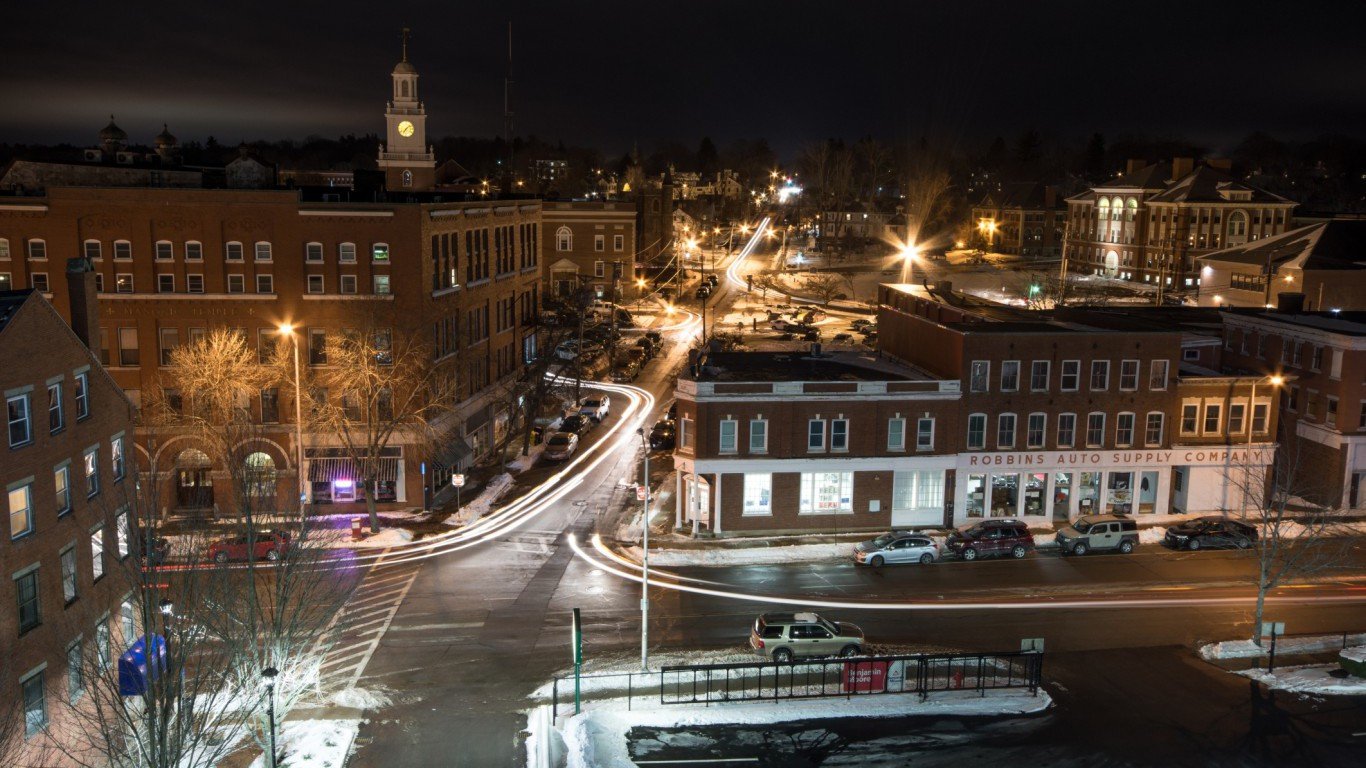
8. New Hampshire
> Concealed carry permit required: No
> Gun ownership rate: 14.4% (5th lowest)
> Firearm-related death rate: 8.9 per 100,000 (11th lowest)
Before the current 2017 legislative session, anyone in New Hampshire could carry a gun exposed without first obtaining a license or permit. To carry concealed weapons, gun owners needed to apply for a license with the local police department. The state’s already relatively relaxed restrictions were further loosened this February when Gov. Chris Sununu approved a bill eliminating the requirement for concealed carry licenses.
Like several other states on this list, notably those in New England, New Hampshire’s gun ownership rate is not especially high. At just 14.4%, the share of adults who own a gun in the state is less than half the comparable national percentage.
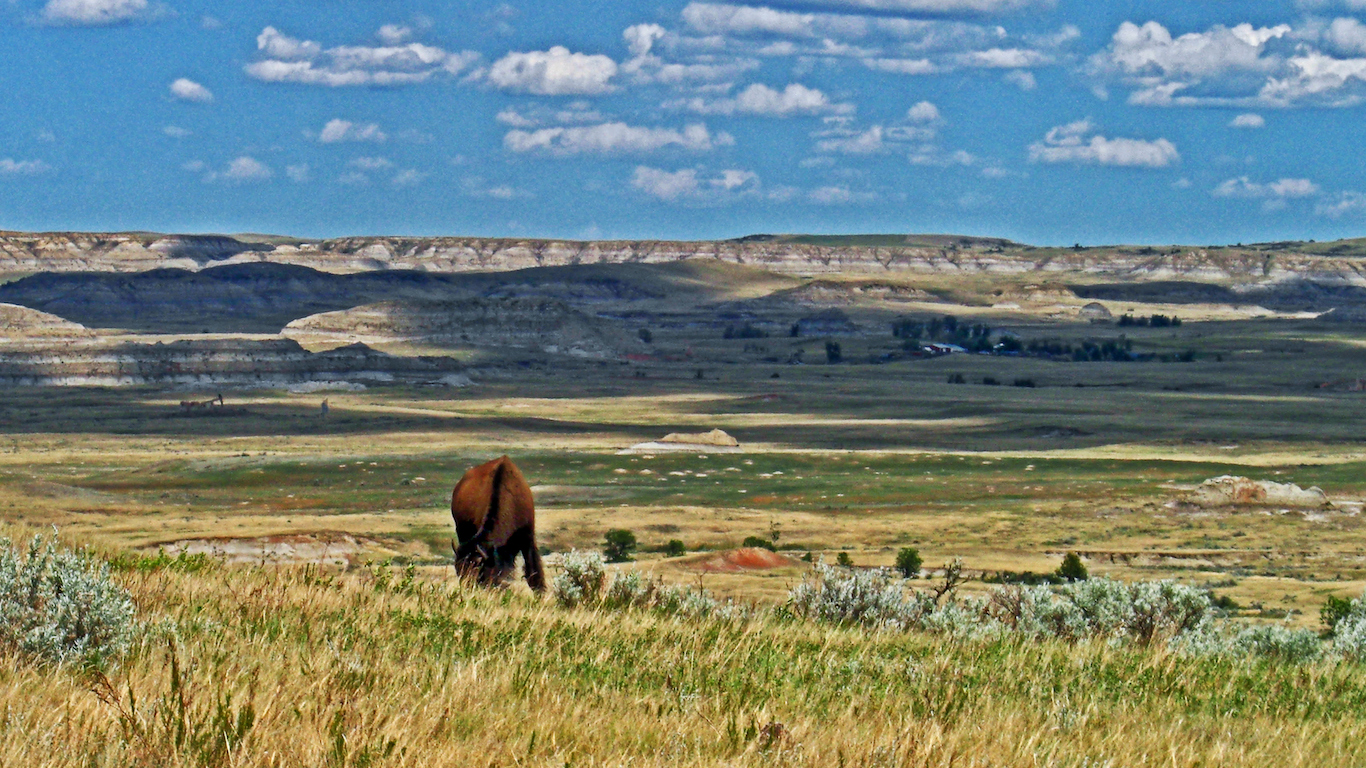
9. North Dakota
> Concealed carry permit required: No
> Gun ownership rate: 47.9% (9th highest)
> Firearm-related death rate: 12.8 per 100,000 (19th highest)
The number of states that do not require a permit to carry a concealed weapon has steadily increased over the years. North Dakota is the latest state to adopt what proponents of loose gun restrictions call “constitutional carry.” As of March 2017, anyone 18 and over in North Dakota can carry firearms hidden on their person without first undergoing a background check or training.
Of course it remains to be seen what effect the weakened restrictions will have. Even so, under the previously more restrictive gun laws North Dakota reported above average gun-related violence and ownership rate. There were 12.8 firearm deaths per 100,000 residents in 2015, and approximately half of all residents own a gun, the 19th and ninth highest rates of all states, respectively.
[in-text-ad]

10. Vermont
> Concealed carry permit required: No
> Gun ownership rate: 28.8% (20th lowest)
> Firearm-related death rate: 9.6 per 100,000 (13th lowest)
Unlike most states, even those on this list, Vermont has never prohibited the carrying of concealed weapons. Vermonters may carry openly or in a concealed manner firearms of all kinds anywhere in the state except for on school property or in a court house. There are also no screening processes such as background checks, quantity limits, or waiting periods required under state law. Those who have committed violent or gun-related misdemeanors, the mentally ill, and drug and alcohol abusers in the state are all legally able to purchase a gun.
Unlike many states on this list, Vermont is one of the safest states in the country. Vermont’s violent crime rate of 118 incidents per 100,000 residents in a year is the lowest of any state, and the firearm-related death rate is 13th lowest.

11. West Virginia
> Concealed carry permit required: No
> Gun ownership rate: 54.2% (4th highest)
> Firearm-related death rate: 14.0 per 100,000 (17th highest)
Adults in West Virginia have been able to carry a concealed, loaded firearm without a permit since early June 2016. As recently as July 2017, protections for gun owners were expanded as the state legislature passed House Bill 2679, which allows unrestricted concealed carry in every public park in West Virginia, regardless of any county or municipal jurisdiction. Newly passed Senate Bill 388 allows individuals to have a loaded weapon in their vehicle while dropping students off at school.
States with less restrictive gun laws often have higher gun ownership rates, and West Virginia is no exception. The state is one of only six where over half of the adult population owns a firearm.
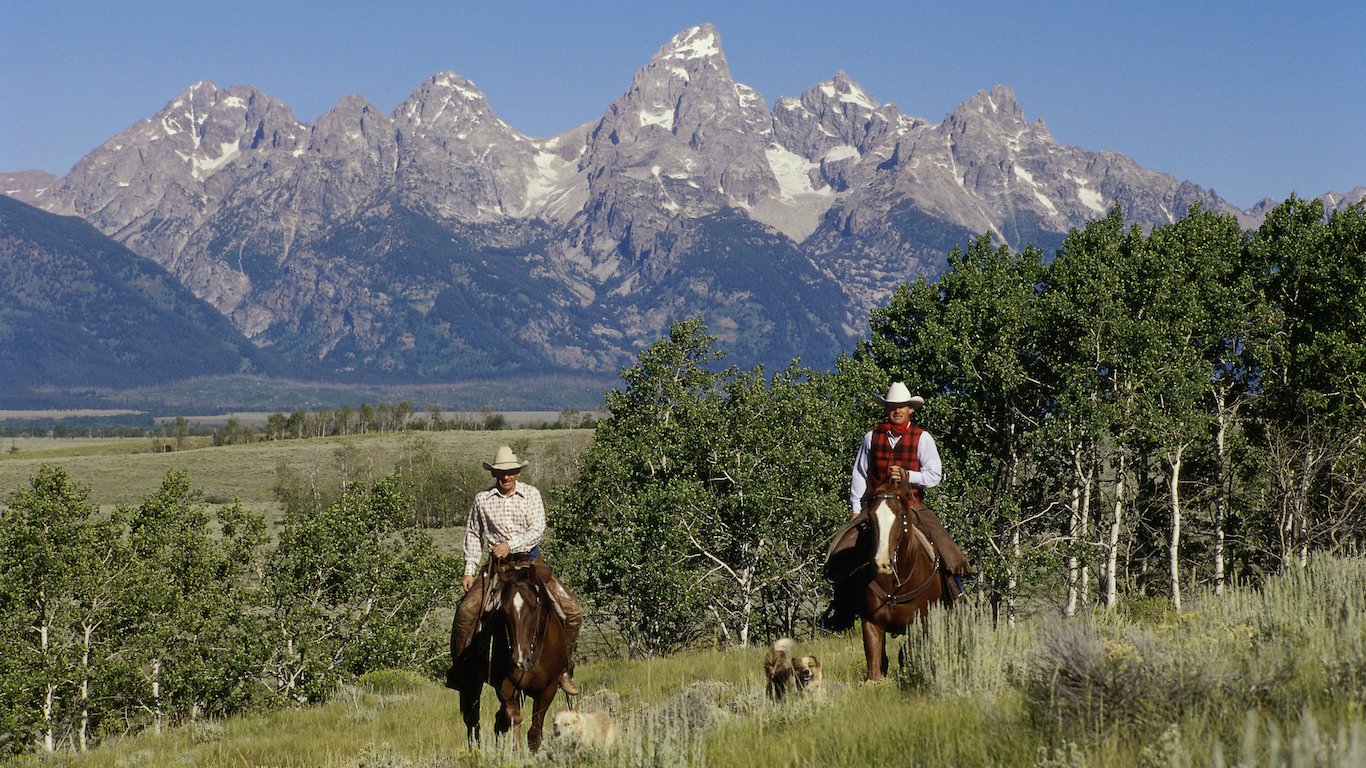
12. Wyoming
> Concealed carry permit required: No
> Gun ownership rate: 53.8% (5th highest)
> Firearm-related death rate: 19.6 per 100,000 (3rd highest)
Gun control advocates often argue that fewer firearm restrictions lead to higher gun circulation, which in turn leads to greater gun use. Higher gun usage rates tend to increase the likelihood of accidents, suicide rates, and homicides. While more guns does not always lead to more gun violence, the argument can certainly be made for Wyoming. One of only six states where most adults own a gun, Wyoming also has one of the highest firearm death rates at nearly 20 for every 100,000 people, third highest of all states.
A paper published by Stanford researcher John Donohue in June 2017 found evidence that right-to-carry laws are directly related to increases in violent crime. An analysis of 10 years of data found that Wyoming has experienced higher violent crime rates than it would have had it not passed its 1995 right-to-carry law. Since the 1990s, the state has steadily loosened its gun restrictions.
Detailed Findings and Methodology
Gun laws are extraordinarily complex and vary considerably between states. The nature of these regulations depend on a state’s legal and political climate. Cultural aspects may also help explain loose gun restrictions in some states. While studies are near universal in their finding that more guns lead to more gun violence, rural U.S. states are often the exception.
Vermont, Maine, and New Hampshire, for example, have some of the nation’s — if not the world’s — most lenient gun laws, but also some of the nation’s lowest gun death rates.
While social gun culture likely helps account for high ownership rates, Anderman argued that cultural aspects do not fully explain the loose restrictions. “The reason [gun restrictions] are not adopted in these states is not because the majority of the people don’t support them, but because their legislatures or legislators are in the pockets of a lobby,” she said.
A poll conducted by public policy think tank Pew Research Center found a majority of both gun owners and non-owners favor limiting access to guns for certain individuals as well as background checks for private sales and at gun shows. According to the Law Center to Prevent Gun Violence, a 2015 poll revealed that 87% of Americans oppose permitless concealed carry laws.
To identify the states where anyone might have a gun, 24/7 Wall St. reviewed states where permits to carry concealed weapons are not required. All data on state gun policy, including concealed carry regulations, came from the Law Center to Prevent Gun Violence. We also reviewed 2015 firearm-related deaths per 100,000 people in each state from the Centers for Disease Control and Prevention. Gun ownership rates for each state are as of 2013 and were obtained from a study published in 2015 from the Mailman School of Public Health at Columbia University in New York. Violent crime rates in each state came from the FBI’s 2015 Uniform Crime Report. All data are for the most recent period for which data is available.
Take the quiz below to get matched with a financial advisor today.
Each advisor has been vetted by SmartAsset and is held to a fiduciary standard to act in your best interests.
Here’s how it works:
1. Answer SmartAsset advisor match quiz
2. Review your pre-screened matches at your leisure. Check out the
advisors’ profiles.
3. Speak with advisors at no cost to you. Have an introductory call on the phone or introduction in person and choose whom to work with in the future
Take the retirement quiz right here.
Thank you for reading! Have some feedback for us?
Contact the 24/7 Wall St. editorial team.